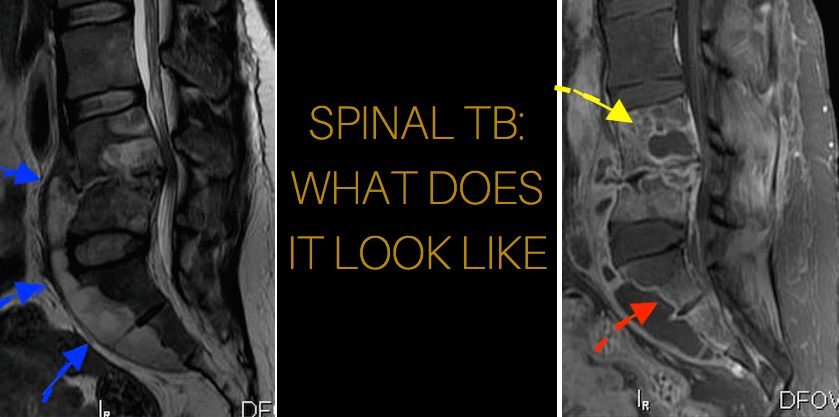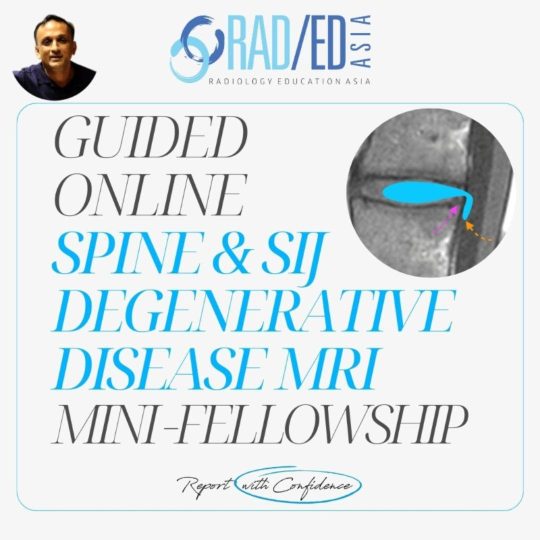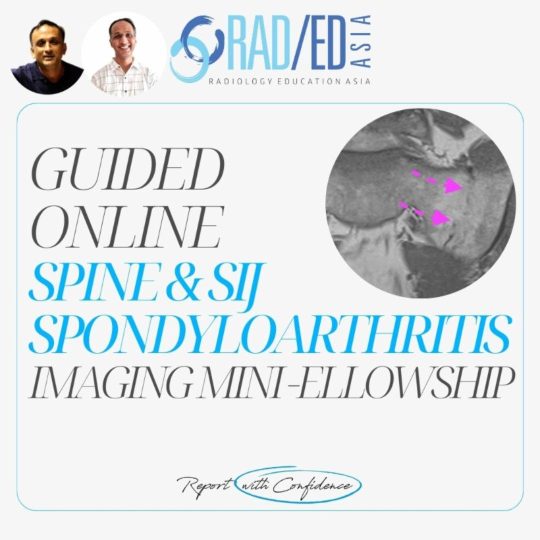
MRI SPINAL TB: WHAT DOES IT LOOK LIKE
MRI SPINE RADIOLOGY TUBERCULOSIS APPEARANCE
MRI findings in spinal TB can vary from being indistinguishable to bacterial spondylodiscitis to changes that are very suggestive of TB. So what are the more suggestive changes of spinal TB on MRI?
Anterior Longitudinal Ligament:
As it often begins in the anterior vertebral body, TB has tendency to spread underneath the ALL more so than in the anterior epidural space, and can track away from the vertebral body/disc it has arisen in.

Image Above: Yellow arrows outline the ALL with phlegmon and an abscess tracking along the undersurface of the ALL. 
Whole Body Involvement and Skip Lesions:
In TB there is a tendency for the whole vertebral body to be involved. Skip lesions can occur either to direct spread from infection tracking under the ALL (see image below) or as separate regions of vertebral body involvement.

Image Above: Whole body involvement of L4 and L5 (Yellow arrow). Whole body involvement more typically seen in TB than in bacterial infections. Also abscess tracking deep to the ALL (Blue arrows) and vertebral body skip lesions S1 and S2 (Red arrow) from direct spread of abscess deep to ALL.
Absence of Disc Involvement:
In bacterial spondylodiscitis, disc involvement is the norm. In TB the disc can be spared, with only involvement of the vertebral body.

Image above: Whole body involvement in mid thoracic spine (Blue arrows) with sparing of disc in between. Image on left same patient skip lesion with involvement of L5 body (Red arrow) but no disc involvement.


Image Above: Endplates (Yellow arrows) and disc (Blue arrow) relatively spared despite significant vertebral body involvement above and below disc. Also note spread below the ALL (Orange arrow).

Cord Ischaemia and Longitudinal Myelitis:
A more rare complication of TB is developing cord ischaemia or a longitudinal myelitis. This is due to ischaemia/ infarction from arterial occlusion secondary to a vasculitis or ischaemia from venous compression/stasis and is seen as increased T2 signal in the cord.

Image Above: Vertebral collapse (Yellow arrow) and epidural infection result in cord compression. Increased cord signal at this level (Blue arrows) secondary to cord compression. Separate, long area of increased cord signal in cervico-thoracic region (Red arrow) with normal intervening cord, presumed secondary to cord ischaemia/ longitudinal myelitis.

Features that suggest TB on MRI findings in spinal TB include: beginning in the anterior vertebral body, spread under the Anterior Longitudinal Ligament, presence of skip lesions, entire or multiple vertebral body involvement, large paraspinal/psoas abscesses, and paraspinal calcification.

TB tends to spread underneath the Anterior Longitudinal Ligament (ALL) over multiple vertebral bodies in the spine.

In bacterial spondylodiscitis, disc involvement is the norm, whereas in TB, the disc can be spared and only the vertebral body is involved.

TB has a tendency to spread underneath the ALL more so than in the anterior epidural space. It tracks away from the vertebral body/disc it has arisen in.

Large paraspinal/psoas abscesses are often seen in cases of TB in the spine.

We look at all of these topics in more detail in our SPINE Imaging Online Guided Mini Fellowships.
Click on the image below for more information.
For all our other current MSK MRI & Spine MRI
Online Guided Mini Fellowships.
Click on the image below for more information.














